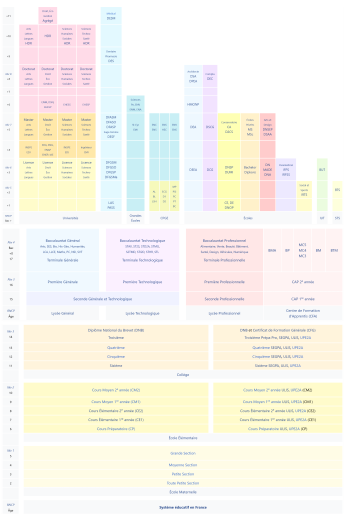France education is characterized and special since the implementation of the obligatory
schooling in the XIX century . This characterization is due to the creation of the French Republican
School, which was obligatory and secular. Its creation was due to the creation of the French Republic
and also to show the separation between govern middle of the XX century. a very deep transformation
related to social changes, the increase of obligatory schooling and the races diversity between
students and also teachers, something which was caused by the intense migration movements.
In France, schooling is obligatory until 16 years. When children are 3, they start their school
age in “L'école maternelle” (Little children school). When students are 4, they go to the “Moyenne”
Medium Section. Then, they go to the Grande Section (High section) when they're five. The following
courses, by increasing order, is: Cours préparatoire, Cours élémentaire 1, cours élémentaire 2, cours
moyen 1 and cours moyen 2 (Preparatory year, Elemental School Year 1 and 2, and Medium School
Year 1 and 2).
From 11 to 18 years, French students go the Secondary School. This period is divided in two
parts; the first ones are called “collèges”, where French students go when they're 11 which finishes
when these are 14. It has four courses ordered in a decreasing rank. The first course is the 6
th one, and the las tone is the 3rd. When students finish the 3rd course, they've got to do the “Brevet”, an exam that isn't really necessary to approve but which gives french government a figure to know how their
students are and what do they know.
Students enter here when they finish the last year of primary school, which uses to be called
“Cours Moyen Deuxième Année”, as it has already been told.
The second schools are “lycées” (higher than Secondary Schools), which are divided in three
courses. It starts when students are 15, and finishes when students are 18. There we can see some
parts. Two of them are the “Lycée général”(General High School), the “Lycée Technologique”(only
Technology School) and the “Lycée Proffesionnel”(Professional High School). The first one is taught in
normal “lycées”, and is oriented to people who want to continue learning and that are probably going
to study a university degree. Also “Lycée Technologique” is studied in normal “lycées”, but it has a
different orientation. There, students want to finish their studies promptly, doing something like the
Spanish CFGS. The “Lycée Professionnel” is oriented to people who isn't planing to study the highest
education. It's especially good for students who don't enjoy learning in academical ambiances
When students finish any of the ways of “lycée”, they got the “Baccalauréat” diploma.
Students from the “Lycée Technologique” and “Lycée Professionnel” go to an specific place to
study an specific area of Technology, in the first case, and in the second one they go to work in a
specific place to learn in that way. Students from the “Lycée Général” usually go to the university.
23 There are two ways to go to the university in France. You can go to a “Grand École”, which is
an institution very specialized in an area of study or you can also go to a university. “Grands écoles”
only admit processors of “Baccalauréat” diploma and 2 years of study in any university. That's one of
the reasons why students usually don't study in an unique organization. Universities don't use to be
very expensive, and student's coming from low economic levels usually receive helps for the
education. If we add that to the fact of that they've got a health insurance until they're 21, we don't
have to be very intelligent to forecast that they don't have got many problems to get high educational
levels. Even so, “Grand École” is something different. It's not an organization from the
government, so they can make you do an exam to test that you're prepared enough. This is why there
preparatory schools which prepare students to these competitive exams at “Grands écoles”. Another
way of getting into those schools is a second selection based on the results of the two lasts years of
“lycée”. The other way is to do 2 years of university or preparatory class.
Even some of those schools just include the preparatory class into the program. The bad thing
about this is that if you're going to do the selection test in another school you'll probably have a
problem, because this preparatory school will prepare you for their selection exam and not for the
others one, so your probabilities of being selected in another school is really low. When students finish
their studies at universities or “Grands écoles” they can opt to the study of a master or doctoral
degree. These studies are like Spanish ones. In a master degree, a student studies an specific area of
 the degree that obtained previously. Its finality is a professional career dedicated to the area of the
the degree that obtained previously. Its finality is a professional career dedicated to the area of the
master.
Doctoral degrees have the finality of giving the student a very deep knowledge of the area of study. Its destiny is to give students the capacity of researching by themselves or with a workgroup.
All the educational
schema from 3 to 18
years old can be perfectly
reduced to the content
shown in the next image.











